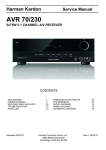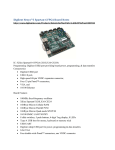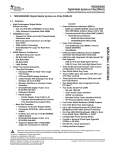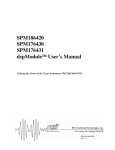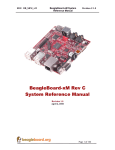Download AM1808 SOM-M1 Hardware Specification
Transcript
AM1808 SOM-M1 Hardware Specification Hardware Documentation Logic PD // Products Published: April 2010 Last revised: May 2011 This document contains valuable proprietary and confidential information and the attached file contains source code, ideas, and techniques that are owned by Logic PD, Inc. (collectively “Logic PD’s Proprietary Information”). Logic PD’s Proprietary Information may not be used by or disclosed to any third party except under written license from Logic PD, Inc. Logic PD, Inc. makes no representation or warranties of any nature or kind regarding Logic PD’s Proprietary Information or any products offered by Logic PD, Inc. Logic PD’s Proprietary Information is disclosed herein pursuant and subject to the terms and conditions of a duly executed license or agreement to purchase or lease equipment. The only warranties made by Logic PD, Inc., if any, with respect to any products described in this document are set forth in such license or agreement. Logic PD, Inc. shall have no liability of any kind, express or implied, arising out of the use of the Information in this document, including direct, indirect, special or consequential damages. Logic PD, Inc. may have patents, patent applications, trademarks, copyrights, trade secrets, or other intellectual property rights pertaining to Logic PD’s Proprietary Information and products described in this document (collectively “Logic PD’s Intellectual Property”). Except as expressly provided in any written license or agreement from Logic PD, Inc., this document and the information contained therein does not create any license to Logic PD’s Intellectual Property. The Information contained herein is subject to change without notice. Revisions may be issued regarding changes and/or additions. © Copyright 2011, Logic PD, Inc. All Rights Reserved. PN 1015746A Logic PD, Inc. All Rights Reserved. i AM1808 SOM-M1 Hardware Specification Revision History REVISION DESCRIPTION Schematic PN & REV APPROVAL DATE Initial release 1015138 Rev A 1015640 Rev A NJK 04/20/10 JCA Added Appendix A and B containing mechanical drawings 1015138 Rev A 1015640 Rev A JCA 09/23/10 3 JCA -Section 2.4: Added Industrial temperature range; Added Caution about system temperatures when enabling SATA; 1015138 Rev A 1015640 Rev A JCA 11/05/10 A -Section 1.5: Updated link for Logic PD hardware design files; -Section 7.1: Updated J1.31 description since this signal is no longer connected to the PMIC; Updated J1.39, 54 descriptions to add resistor value; -Section 7.2: Updated J2.91, 97, & 99 descriptions to add resistor value; uP_EPWM0_TZ[0] is now connected to J2.99; -Section 7.3: Added resistor value to J3.54 description; SMC, JCA uP_SPI1_SCSn0 is now connected to J3.36 1015115 Rev C 1015774 Rev B JCA 05/04/11 REV 1 2 EDITOR JCA Please check www.logicpd.com for the latest revision of this document, product change notifications, and additional documentation. PN 1015746A Logic PD, Inc. All Rights Reserved. ii AM1808 SOM-M1 Hardware Specification Table of Contents 1 2 3 4 5 Introduction ........................................................................................................................................... 1 1.1 Product Overview ............................................................................................................................. 1 1.2 Abbreviations, Acronyms, & Definitions ........................................................................................... 1 1.3 Nomenclature ................................................................................................................................... 2 1.4 Scope of Document.......................................................................................................................... 2 1.5 Additional Documentation Resources .............................................................................................. 2 Functional Specification ...................................................................................................................... 3 2.1 Processor ......................................................................................................................................... 3 2.1.1 AM1808 Processor .................................................................................................................... 3 2.1.2 AM1808 Processor Block Diagram ........................................................................................... 4 2.2 SOM Interface .................................................................................................................................. 4 2.2.1 AM1808 SOM-M1 Block Diagram ............................................................................................. 5 2.3 Mechanical Specifications ................................................................................................................ 5 2.3.1 Mechanical Characteristics of SOM .......................................................................................... 5 2.3.2 Interface Connectors ................................................................................................................. 6 2.4 Temperature Specifications ............................................................................................................. 6 Electrical Specification ........................................................................................................................ 7 3.1 Absolute Power Maximum Ratings .................................................................................................. 7 3.2 Recommended Power Operating Conditions................................................................................... 7 Peripheral Specification ....................................................................................................................... 8 4.1 Clocks............................................................................................................................................... 8 4.2 Memory ............................................................................................................................................ 8 4.2.1 Mobile DDR ............................................................................................................................... 8 4.2.2 SPI Flash ................................................................................................................................... 8 4.3 10/100 Ethernet PHY ....................................................................................................................... 8 4.4 Display Interface .............................................................................................................................. 9 4.5 Serial Interfaces ............................................................................................................................... 9 4.5.1 UART0-2 .................................................................................................................................... 9 4.5.2 SPI0/1 ........................................................................................................................................ 9 4.5.3 I2C0/1 ........................................................................................................................................ 9 4.5.4 McBSP0/1 ................................................................................................................................ 10 4.5.5 McASP0 ................................................................................................................................... 10 4.6 USB Interface ................................................................................................................................. 10 4.7 ADC/Touch Interface...................................................................................................................... 10 4.8 General Purpose I/O (GPIO) .......................................................................................................... 10 4.9 Expansion/Feature Options ........................................................................................................... 10 System Integration ............................................................................................................................. 12 5.1 Custom Configuration .................................................................................................................... 12 5.2 Resets ............................................................................................................................................ 12 5.2.1 Master Reset (MSTR_nRST)—Reset Input ............................................................................ 12 5.2.2 SOM Reset (RESETOUTn)—Reset output ............................................................................. 12 5.3 Interrupts ........................................................................................................................................ 13 5.4 JTAG Debugger Interface .............................................................................................................. 13 5.5 Power Management ....................................................................................................................... 13 5.5.1 System Power Supplies ........................................................................................................... 13 5.5.1.1 5V ...................................................................................................................................... 13 5.5.1.2 USB0_VBUS ..................................................................................................................... 13 5.5.1.3 MAIN_BATT_IN ................................................................................................................ 14 5.5.1.4 VRTC_IN ........................................................................................................................... 14 5.5.2 Dual Voltage I/O ...................................................................................................................... 14 5.5.3 System Power Management ................................................................................................... 14 5.5.4 Microprocessor ........................................................................................................................ 15 5.6 ESD Considerations ....................................................................................................................... 15 PN 1015746A Logic PD, Inc. All Rights Reserved. iii AM1808 SOM-M1 Hardware Specification 6 7 Memory & I/O Mapping ....................................................................................................................... 16 Pin Descriptions & Functions ........................................................................................................... 17 7.1 J1 Connector 100-Pin Descriptions ............................................................................................... 17 7.2 J2 Connector 100-Pin Descriptions ............................................................................................... 23 7.3 J3 Connector 100-Pin Descriptions ............................................................................................... 27 Appendix A: SOM-M1 Mechanical Drawing ............................................................................................ 31 Appendix B: Example SOM-M1 Retention Methods .............................................................................. 33 PN 1015746A Logic PD, Inc. All Rights Reserved. iv AM1808 SOM-M1 Hardware Specification Table of Figures Figure 2.1: AM1808 Processor Block Diagram ............................................................................................. 4 Figure 2.2: AM1808 SOM-M1 Block Diagram............................................................................................... 5 PN 1015746A Logic PD, Inc. All Rights Reserved. v AM1808 SOM-M1 Hardware Specification 1 Introduction 1.1 Product Overview The AM1808 System on Module (SOM) is a compact, product-ready hardware and software solution that fast forwards embedded designs while reducing risk and controlling cost. Based on Texas Instruments' AM1808 processor and designed in the SOM-M1 form factor, the AM1808 module offers essential features for handheld and embedded networking applications. The AM1808 SOM-M1 brings the industry leading low power ARM926 core to a small, off-theshelf solution. The standard SOM-M1 form factor allows developers to reuse existing baseboard designs when upgrading to new Sitara processors, which extends roadmap possibilities for their end-product. Two Zoom™ Development Kit options allow developers to choose the platform best suited to their application needs. By starting with the corresponding Zoom Development Kit, engineers can write application software on the same hardware that will be used in their final product. The compact size of the AM1808 SOM-M1 is ideal for medical patient monitoring wearables and other portable instrumentation applications; the built-in Serial ATA (SATA) controller provides fast access to large capacity storage devices. For medical, industrial, audio, and communication products, the AM1808 SOM-M1 allows for powerful versatility, long-life, and greener products. 1.2 Abbreviations, Acronyms, & Definitions ADC BOM BSP BTB DAC DMA EDMA EMIFA ESD FIFO HPI GPIO GPMC Hi-Z I2C I2S IC I/O IRQ LCD LDO McASP McBSP mDDR MDIO MMU MPU OTG PN 1015746A Analog to Digital Converter Bill of Materials Board Support Package Board-to-Board Digital to Analog Converter Direct Memory Access Enhanced Direct Memory Access External Memory Interface Electrostatic Discharge First In First Out Host Port Interface General Purpose Input Output General Purpose Memory Controller High Impedance Inter-Integrated Circuit Inter-Integrated Circuit Sound Integrated Circuit Input/Output Interrupt Request Liquid Crystal Display Low Dropout (Regulator) Multi-channel Audio Serial Port Multi-channel Buffered Serial Port Mobile Double Data Rate (RAM) Management Data Input/Output Memory Management Unit Memory Protection Unit (ARM processor core) On-the-Go (USB) Logic PD, Inc. All Rights Reserved. 1 AM1808 SOM-M1 Hardware Specification PCB PCMCIA PHY PLL PWM RTC SATA SDRAM SOM SOM-M1 SPI STN TFT TI TSC UART uPP USB VLIW VPIF 1.3 Printed Circuit Board Personal Computer Memory Card International Association (PC Cards) Physical Layer Phase Lock Loop Pulse Width Modulation Real Time Clock Serial ATA Synchronous Dynamic Random Access Memory System on Module SOM form factor type used for the AM1808 modules Standard Programming Interface Super-Twisted Nematic (LCD) Thin Film Transistor (LCD) Texas Instruments Touch Screen Controller Universal Asynchronous Receive Transmit Universal Parallel Port Universal Serial Bus Very Long Instruction Word Video Port Interface Nomenclature The terms “SOM” and “SOM-M1” are used interchangeably throughout this document and can be assumed to mean the same thing within this text. The SOM-M1 is a specific form factor type of Logic PD’s SOM. 1.4 Scope of Document This Hardware Specification is unique to the design and use of the AM1808 SOM-M1 as designed by Logic PD and does not intend to include information outside of that scope. Detailed information about the Texas Instruments (TI) AM1808 processor or any other device component on the SOM can be found in their respective manuals and specification documents; please see Section 1.5 for additional resources. 1.5 Additional Documentation Resources The following documents or documentation resources are referenced within this Hardware Specification. ■ TI’s AM1808 ARM Microprocessor Datasheet, User Guides, Application Notes, White Papers, and Errata http://www.ti.com/am1808 ■ TI’s TPS65070 Datasheet http://focus.ti.com/docs/prod/folders/print/tps65070.html ■ USB 2.0 Specification, available from USB.org http://www.usb.org/developers/docs/ ■ U-Boot documentation http://www.denx.de/wiki/U-Boot/WebHome ■ Logic PD AM1808 Hardware Design Files (BOM, Schematic, and Layout) for all boards included in the development kits, as well as all standard configurations SOMs. Sign into your account on Logic PD’s website to access the files for your specific development kit and SOM. http://support.logicpd.com/auth/ PN 1015746A Logic PD, Inc. All Rights Reserved. 2 AM1808 SOM-M1 Hardware Specification 2 Functional Specification 2.1 Processor 2.1.1 AM1808 Processor The AM1808 SOM-M1 uses TI’s high-performance AM1808 microprocessor. This device contains an ARM926EJ-S MPU core and provides many integrated on-chip peripherals, including: ■ ■ ■ ■ ■ ■ ■ ■ ■ ■ ARM® ARM926EJ-S™ RISC core Integrated LCD Controller □ Up to 1024 x 1024 x 16 bit color Three UARTs I2S codec interface Universal Serial Bus (USB) □ One high-speed USB 2.0 On-the-Go (OTG) interface □ One full-speed USB 1.1 host interface Serial ATA Controller □ SATA I (1.5Gb/s) or SATA II (3Gb/s) Many general purpose I/O (GPIO) signals Programmable timers Real time clock (RTC) Low power modes IMPORTANT NOTE: The AM1808 processor pinout is heavily multiplexed; using one peripheral may preclude the use of another. Users should carefully review the processor pinout, SOM pinout, and AM1808 multiplexing table. See TI’s AM1808 ARM Microprocessor Datasheet, User Guides, and Application Notes for additional information. IMPORTANT NOTE: Please visit TI’s website for errata on the AM1808; http://www.ti.com/am1808. PN 1015746A Logic PD, Inc. All Rights Reserved. 3 AM1808 SOM-M1 Hardware Specification 2.1.2 AM1808 Processor Block Diagram Figure 2.1: AM1808 Processor Block Diagram Note: The block diagram pictured above comes from TI’s AM1808 ARM Microprocessor Data Sheet (document number SPRS653–February 2010). Available from TI’s website: http://www.ti.com/am1808. 2.2 SOM Interface Logic PD’s common SOM interface allows for easy migration to new processors and technology. Logic PD is constantly researching and developing new technologies to improve performance, lower cost, and increase feature capabilities. By using the common SOM footprint, it is possible to take advantage of Logic PD’s work without having to re-spin the old design in certain cases dependent upon peripheral usage. Contact Logic PD sales for more information ([email protected]). In fact, encapsulating a significant amount of your design onto the SOM reduces any long-term risk of obsolescence. If a component on the SOM design becomes obsolete, Logic PD will simply design for an alternative part that is transparent to your product. Furthermore, Logic PD tests all SOMs prior to delivery, decreasing time-to-market and ensuring a simpler and less costly manufacturing process. PN 1015746A Logic PD, Inc. All Rights Reserved. 4 AM1808 SOM-M1 Hardware Specification 2.2.1 AM1808 SOM-M1 Block Diagram Figure 2.2: AM1808 SOM-M1 Block Diagram 2.3 Mechanical Specifications 2.3.1 Mechanical Characteristics of SOM Parameter Min Typical Max Unit Notes Dimensions — 30 x 40 x 4.1 — mm 1 Weight — 7 — Grams 2 Connector Insertion/Removal — 30 — Cycles — Notes: 1. The AM1808 SOM-M1 in the Zoom AM1808 EVM Development Kit includes power measurement circuitry along one edge of the SOM. This additional circuitry increases the PCB size to 33.7 x 40 x 4.1 mm. All other AM1808 SOM-M1 modules, including those available in production volumes, are the typical size listed above. 2. May vary depending on SOM configuration. PN 1015746A Logic PD, Inc. All Rights Reserved. 5 AM1808 SOM-M1 Hardware Specification 2.3.2 Interface Connectors The AM1808 SOM-M1 connects to a PCB baseboard through three 100-pin board-to-board (BTB) socket connectors. 2.4 Ref Designator Manufacturer SOM Connector P/N Mating Connector P/N J1, J2, J3 Hirose DF40C-100DP-0.4V(51) DF40C-100DS-0.4V(51) Temperature Specifications Parameter Min Typical Max Unit Notes 0 25 70 °C — Industrial Operating Temperature -40 25 85 °C — Storage Temperature -40 25 85 °C — Commercial Operating Temperature CAUTION: Systems using the SATA interface on the AM1808 SOM-M1 may require additional heat dissipation techniques in order to comply with the high end of the system temperature limitation. It is the responsibility of the engineer to ensure the AM1808 SOM-M1 maintains a safe operating temperature within the system. PN 1015746A Logic PD, Inc. All Rights Reserved. 6 AM1808 SOM-M1 Hardware Specification 3 Electrical Specification 3.1 Absolute Power Maximum Ratings Parameter Symbol Rating Unit DC 5 V Supply Voltage 5V 0.0 to 7.0 V DC Main Battery Input Voltage MAIN_BATT_IN 0.0 to 7.0 V RTC Backup Battery Voltage BACKUP_BATT 0.0 to 7.0 V NOTE: These stress ratings are only for transient conditions. Operation at, or beyond, absolute maximum rating conditions may affect reliability and cause permanent damage to the SOM and its components. 3.2 Recommended Power Operating Conditions Parameter Min Typical Max DC Main Battery Input Voltage 3.3 3.6 4.2 DC 5V Voltage 3.6 5.0 DC 5V Active Current — 250 DC 5V Active Current, no SATA — DC RTC Backup Battery Voltage 1.8 Unit Notes V 4 5.8 V 3 — mA 5 151 — mA 6 3.3 3.6 V VREF V 2 0.65*VREF (1.8V) Input Signal High Voltage 2 (3.3V) — Input Signal Low Voltage GND — 0.8 (3.3V) V 2 VREF V 2 V 2 0.35*VREF (1.8V) 2.40 (3.3V) Output Signal High Voltage VREF-0.45 (1.8V) — Output Signal Low Voltage GND — 0.40 (3.3V) 0.45 (1.8V) Notes: 1. General note: CPU power rails are sequenced on the module. 2. VREF represents the peripheral I/O supply reference for the specific CPU voltage rail. For VI/OH and VI/OL, different values are provided for VREF = 1.8V and 3.3V. 3. Please see Section 5.5.1.1 for detailed information about 5V usage on the AM1808 SOM-M1. 4. Please see Section 5.5.1.3 for detailed information about MAIN_BATT_IN usage on the AM1808 SOM-M1. 5. Measurement was taken with a system consisting of SOM and baseboard. The SOM was running the standard U-Boot software image, version 2009.11. This power measurement represents current consumption on the SOM only (baseboard and UI board were excluded). 6. Same setup as Note 5 with the exception that the SATA clock generator was disabled by populating R146. PN 1015746A Logic PD, Inc. All Rights Reserved. 7 AM1808 SOM-M1 Hardware Specification 4 Peripheral Specification 4.1 Clocks The AM1808 SOM-M1 contains two crystals. One crystal is used to generate clocks for the processor core(s) and peripherals. The second crystal is dedicated to the RTC module. The AM1808 processor includes on-chip Phase Locked Loops (PLLs) and signal dividers which generate all core/peripheral clocks from a single external 24.000 MHz crystal. The maximum core processor operating frequency is 450 MHz. Optionally, on-chip module PLL0 provides an output: SOM Pin# SOM Net Name AM1808 Processor Pin J3.18 uP_OBSCLK CLKOUT/ UHPI_HDS2/ GP6[14] IMPORTANT NOTE: Please see TI’s AM1808 ARM Microprocessor Datasheet and User Guides for additional information about processor clocking. The AM1808 processor also contains an on-chip Real Time Clock (RTC) module which is driven by an external 32.768 kHz crystal. The highly configurable RTC module provides a time reference to applications running on the AM1808. The SOM contains a dedicated power input pin (J2.64, “VRTC_IN”) and low dropout (LDO) which supplies the processor’s dedicated RTC power rail (RTC_CVDD) IMPORTANT NOTE: For more information on RTC power, see Section 5.5.1.4. For more information about software configuration of the RTC, see TI’s AM1808 ARM Microprocessor Datasheet and User Guides. 4.2 Memory 4.2.1 Mobile DDR The AM1808 SOM-M1 provides volatile memory via a single mDDR chip. Please refer to the AM1808 SOM-M1 Bill of Materials (BOM) for the memory density of your specific SOM. Other memory densities may be available for SOMs in production volumes. Please contact Logic PD Sales about custom configurations if your design requires different memory densities from Logic PD’s standard SOM configurations: [email protected]. 4.2.2 SPI Flash The AM1808 SOM-M1 provides non-volatile memory via an 8 MB SPI flash chip. This is also the default boot device. Other memory densities may be available for SOMs in production volumes. Please contact Logic PD Sales about custom configurations if your design requires different memory densities from Logic PD’s standard SOM configurations: [email protected]. 4.3 10/100 Ethernet PHY The AM1808 SOM-M1 uses an SMSC LAN8710 Ethernet PHY to provide an easy-to-use networking interface. The four analog PHY interface signals (transmit/receive) each require an external impedance matching circuit to operate properly. Logic PD provides an example circuit PN 1015746A Logic PD, Inc. All Rights Reserved. 8 AM1808 SOM-M1 Hardware Specification schematic in the AM1808 Baseboard Schematics. Please note the TX+/- and RX+/- pairs must be routed as differential pairs on the baseboard PCB. 4.4 Display Interface The AM1808 has a built-in LCD controller supporting both synchronous (raster-type) and asynchronous (memory-mapped) panels. The synchronous (raster) module supports STN, color STN, and TFT panels at a resolution of up to 1024 x 1024 x 16-bit color. The asynchronous (memory-mapped) module supports a broad range of displays from monochrome character displays to TFT smart LCD panels. Displays driven by this module must contain their own memory and timing circuitry. The signals from the AM1808 LCD controller can be interfaced through the expansion connectors. See TI’s AM1808 ARM Microprocessor Datasheet for further information on the integrated LCD controller. IMPORTANT NOTE: Using the internal graphics controller will affect processor performance. Selecting display resolutions and color bits per pixel will vary processor busload. 4.5 Serial Interfaces The AM1808 SOM-M1 comes with the following serial channels: UART0-2, SPI0/1, I2C0/1, McBSP0/1, and McASP. If additional serial channels are required, please contact Logic PD for reference designs. Please see TI’s AM1808 User Guides for further information regarding serial communications. 4.5.1 UART0-2 The AM1808 SOM-M1 provides three UART ports. UART0, UART1, and UART2 are asynchronous 16C550-compatible UARTs. These UARTs are high-speed serial interfaces that use 16-byte TX and RX FIFO registers; they are capable of sending and receiving serial data simultaneously. The signals from the SOM are not RS232 level signals. The end-product design must provide an external transceiver for RS232 applications. Logic PD has provided an example reference design with the Zoom AM1808 Development Kits. When choosing an RS232 transceiver, the designer should keep in mind cost, availability, ESD protection, and data rates. UART2 has been configured as the main SOM serial port. The UART2 baud rate is set to a default 115.2 Kbits/sec, though it supports most common serial baud rates. 4.5.2 SPI0/1 The AM1808 SOM-M1 provides two SPI ports with multiple chip selects. SPI1 is the default boot source for the AM1808 SOM-M1. A serial flash chip is attached to SPI1 CS0. 4.5.3 I2C0/1 The AM1808 SOM-M1 provides two I2C ports. The clock and data signals for both ports have 4.7K pull-up resistors to their respective power rails on the SOM. Please see TI’s AM1808 User Guides for further information. PN 1015746A Logic PD, Inc. All Rights Reserved. 9 AM1808 SOM-M1 Hardware Specification I2C0 has been configured as the main SOM I2C port. I2C0 is used to control/configure many ICs on the SOM as well as the Zoom AM1808 Development Kits. 4.5.4 McBSP0/1 The AM1808 SOM-M1 supports two Multi-channel Buffered Serial Port (McBSP) interfaces. These interfaces are primarily designed to support AC97 and IIS modes, but they can also be configured for other serial formats. However, the McBSPs are not intended to be used as highspeed interfaces. 4.5.5 McASP0 The AM1808 SOM-M1 supports one Multi-channel Audio Serial Port (McASP). The McASP interface supports TDM streams, I2S protocols, and DIT. Logic PD has provided an example reference design with the Zoom AM1808 Development Kits; this reference design interfaces the AM1808 McASP to a TLV320AIC3106 audio codec. 4.6 USB Interface The AM1808 SOM-M1 supports one USB 1.1 full-speed host port and one USB 2.0 OTG port, which can function as a host or device/client. The USB 2.0 port can operate at up to 480 Mbit/sec, and the USB 1.1 port can operate at up to 12 Mbit/sec. Both the USB 1.1 and USB 2.0 controllers are internal to the AM1808 processor. For more information on using both the USB host and OTG interfaces, please see TI’s AM1808 User Guides. IMPORTANT NOTE: In order to correctly implement USB on the SOM, additional impedance matching circuitry may be required on the USBx_D+ and USBx_D- signals before they can be used. USB 2.0 requirements specify the signals must be routed as differential pairs with a 90 ohm differential impedance. Refer to the USB 2.0 Specification for detailed information. 4.7 ADC/Touch Interface The touch screen controller (TSC) on the AM1808 SOM-M1 is an integrated feature of the TPS65070 PMIC. This TSC is used to support standard 4-wire resistive touch panels. The TPS65070 is connected to the AM1808 by the I2C0 interface. Please see TI’s TPS65070 Datasheet for more information. 4.8 General Purpose I/O (GPIO) Logic PD designed the AM1808 SOM-M1 to be flexible and provide multiple options for analog and digital GPIO. There are numerous digital GPIO pins on the SOM that interface to the AM1808. See Section 7 of this document for more information. If certain peripherals are not desired, such as the LCD controller, chip selects, IRQs, or UARTs, then more GPIO pins become available. 4.9 Expansion/Feature Options The AM1808 SOM-M1 was designed for expansion and a variable feature set, providing all the necessary control signals and bus signals to expand the user’s design. Some of these signals are buffered before reaching the expansion connectors. See TI’s AM1808 ARM Microprocessor Datasheet and User Guides and Logic PD’s AM1808 SOM-M1 Schematics for more details. Logic PD has experience implementing additional options, including: audio codecs, Ethernet ICs, PN 1015746A Logic PD, Inc. All Rights Reserved. 10 AM1808 SOM-M1 Hardware Specification co-processors, and components on SOMs. Please contact Logic PD for potential reference designs before selecting your peripherals. PN 1015746A Logic PD, Inc. All Rights Reserved. 11 AM1808 SOM-M1 Hardware Specification 5 System Integration 5.1 Custom Configuration The AM1808 SOM-M1 was designed to meet multiple applications for users with specific design and budget requirements. As a result, this SOM supports a variety of embedded operating systems, flexible mDDR and SPI flash memory footprints, and other hardware configurations. If your application needs require unique hardware or software configurations, please contact Logic PD Sales about custom SOMs available in production volumes: [email protected]. 5.2 Resets The AM1808 SOM-M1 has a reset input (MSTR_nRST) and a reset output (RESETOUTn). External devices use MSTR_nRST to assert reset to the product. The AM1808 SOM-M1 uses RESETOUTn to indicate to other devices that the SOM is in reset. 5.2.1 Master Reset (MSTR_nRST)—Reset Input Logic PD suggests that custom designs implementing the AM1808 SOM-M1 use the MSTR_nRST signal as the “pin-hole” reset used in commercial embedded systems. The MSTR_nRST triggers a power-on-reset event to the AM1808 processor and resets the entire CPU. IMPORTANT NOTE: Any custom reset circuit design should guard the assertion of the reset lines during a low power state so as to prevent power-up in a low or bad power condition. (Powering up in a low or bad power condition will cause data corruption and, possibly, temporary system lockup). See the “Power Management” section of this document for further details. A low pulse on the MSTR_nRST signal will cause a system-wide reset. Low Pulse on MSTR_nRST Signal: A low pulse on the MSTR_nRST signal, asserted by an external source (for example, the reset button on the custom design application) will bring MSTR_nRST low until the assertion source is de-asserted. There is no delay beyond the de-assertion of the external MSTR_nRST signal source, so the custom design must ensure that the assertion time is sufficient for all related peripherals. Logic PD suggests that for any external assertion source that triggers the MSTR_nRST signal, analog or digital, de-bouncing should be used to generate a clean, one-shot reset signal. 5.2.2 SOM Reset (RESETOUTn)—Reset output All hardware peripherals should connect their hardware-reset pin to the RESETOUTn signal on the expansion connector. Internally, all AM1808 SOM-M1 peripheral hardware reset pins are connected to the RESET_nOUT net. If the output of the onboard voltage-monitoring circuit is asserted (active low), the user can expect to lose information stored in RAM. The data loss occurs because the CPU is reset to its reset defaults. PN 1015746A Logic PD, Inc. All Rights Reserved. 12 AM1808 SOM-M1 Hardware Specification 5.3 Interrupts The AM1808 interrupt controller allows the ARM core to enable, disable, trigger, or service all interrupts. Most external GPIO signals can also be configured as interrupt inputs by configuring their pin control registers. Logic PD BSPs setup and process all onboard system and external SOM interrupt sources. Refer to TI’s AM1808 ARM Microprocessor Datasheet and User Guides for further information on using interrupts. 5.4 JTAG Debugger Interface The JTAG connection on the AM1808 allows recovery of corrupted flash memory, real-time application debug, and ARM core development. There are several third-party JTAG debuggers available for TI microprocessors. The following signals make up the JTAG interface to the AM1808 processor: TDI, TMS, TCK, TDO, nTRST, RTCK, EMU0, EMU1, and MSTR_nRST (MSTR_nRST is only required for some JTAG tools; see the JTAG tool documentation for exact pinout). These signals should interface directly to a 14 or 20-pin 0.1” through-hole connector, as shown on Logic PD’s AM1808 Baseboard Schematic. IMPORTANT NOTE: When laying out the JTAG connector, realize that it may not be numbered as a standard 14 or 20-pin 0.1” insulation displacement connector (IDC) through-hole connector. See the AM1808 Baseboard Schematic for further details. Each JTAG tool vendor may define the IDC connector pin-out differently. 5.5 Power Management 5.5.1 System Power Supplies In order to ensure a flexible design, the AM1808 SOM-M1 has the following power areas: MAIN_BATT_IN, 5V, RTC_BATT. All power areas are inputs to the SOM. The module also provides output reference voltage 3.3V_or_1.8V. 3.3V_or_1.8V is an output from the SOM, and should only be used as a reference voltage input to level shifting devices on baseboard designs. IMPORTANT NOTE: If USB0_VBUS is powered externally it will power the SOM, even if MAIN_BATT_IN and 5V are disconnected. Additionally, USB0_VBUS can charge MAIN_BATT_IN. Please refer to the TPS65070 Datasheet for more information. 5.5.1.1 5V The 5V input is the main source of power for the AM1808 SOM-M1. If power is present at the 5V input, the TPS65070 PMIC will preferentially select this power source over all other sources. If appropriate voltage is applied to the 5V input, the TPS65070 PMIC and AM1808 processor will immediately start up and run. 5V input is capable of charging MAIN_BATT_IN. For startup, acceptable 5V input range is: 3.6V < 5V input < 5.8V At runtime, 5V range is: UVLO < 5V input < 5.8V UVLO = UnderVoltage LockOut UVLO = 3.0V (default), 2.8V < UVLO < 3.25V (programmable) 5.5.1.2 USB0_VBUS USB0_VBUS is an optional power source for the AM1808 SOM-M1. If power is present at the USB0_VBUS input, the TPS65070 PMIC will preferentially select this source over PN 1015746A Logic PD, Inc. All Rights Reserved. 13 AM1808 SOM-M1 Hardware Specification MAIN_BATT_IN. If appropriate voltage is applied to the USB0_VBUS input, the TPS65070 PMIC and AM1808 processor will immediately start up and run. The USB0_VBUS input is capable of charging MAIN_BATT_IN. 5.5.1.3 MAIN_BATT_IN The MAIN_BATT_IN input is designed to be connected to a typical single lithium-ion battery. The TPS65070 PMIC will only power the SOM from MAIN_BATT_IN if power is not present at 5V or USB0_VBUS inputs. If appropriate voltage is applied to the MAIN_BATT_IN input, the TPS65070 PMIC and AM1808 processor will NOT immediately start up and run; a momentary low signal is also required on the PMIC_PB_IN pin. The TPS65070 PMIC is capable of charging MAIN_BATT_IN from either the 5V input or the USB0_VBUS input. For startup, MAIN_BATT_IN range is: 3.6V < MAIN_BATT_IN < 4.2V At runtime, MAIN_BATT_IN range is: UVLO < MAIN_BATT_IN < 4.2V UVLO = UnderVoltage LockOut UVLO = 3.0V (default), 2.8V < UVLO < 3.25V (programmable) IMPORTANT NOTES: Though UVLO may be set as low as 2.8V, not all AM1808 SOM-M1 circuits are capable of 2.8V operation. The SOM contains an internal 3.3V power rail, and devices connected to this rail may have dropout voltages much greater than UVLO. See Section 3.2 for the recommended range of input voltages. Before designing a system which powers the AM1808 SOM-M1 from MAIN_BATT_IN, the user should first review the following documents: TPS65070 Datasheet, AM1808 SOM-M1 Schematic, and AM1808 Baseboard Schematic. 5.5.1.4 VRTC_IN The VRTC_IN power rail is used to power the onboard RTC module. Always power this rail to maintain the clock of the product. A lithium-ion coin cell typically supplies power to this rail. 5.5.2 Dual Voltage I/O The AM1808 processor and AM1808 SOM-M1 uniquely support dual-voltage I/O. The user may select an operating voltage of either 1.8V or 3.3V through “IO_VOLTAGE_SEL” J1.37. For 3.3V operation, J1.37 should be left unconnected. For 1.8V operation, J1.37 should be tied directly to GND. 5.5.3 System Power Management Good power management design is important in any system development and embedded system design is no exception. In embedded system design, power management is typically one of the most complicated areas due to the dramatic effect it has on product cost, performance, usability, and overall customer satisfaction. Many factors affect a power-efficient hardware design: power supply selection (efficiency), clocking design, IC and component selection, etc. The AM1808 SOM-M1 was designed with these aspects in mind while also providing maximum flexibility in software and system integration. On the AM1808 there are many different software configurations that drastically affect power consumption: microprocessor core clock frequency, bus clock frequency, peripheral clocks, bus PN 1015746A Logic PD, Inc. All Rights Reserved. 14 AM1808 SOM-M1 Hardware Specification modes, power management states; peripheral power states and modes; product user scenarios; interrupt handling; and display settings (resolution, backlight, refresh, bits per pixel, etc). These settings are typically initialized in the startup software routines and may be modified later in the operating system and application software. Information for these items can be found in the appropriate documents such as the U-Boot User’s Manual, TI’s AM1808 ARM Microprocessor Datasheet and User Guides, TPS65070 Datasheet, and Logic PD’s AM1808 SOM-M1 Schematic. 5.5.4 Microprocessor The AM1808 processor’s power management scheme was designed for ultra-low power, so naturally the static and dynamic power consumption has very flexible controls allowing designers to configure the processor to minimize end-product power consumption. Most peripheral modules can be powered on/off individually, and the core(s) can enter various levels of standby/sleep. To implement a low-power system, users should review TI’s AM1808 ARM Microprocessor Datasheet and User Guides, TPS65070 Datasheet, and Logic PD’s AM1808 SOM-M1 Schematic. 5.6 ESD Considerations The AM1808 SOM-M1 was designed to interface to a customer’s peripheral board, while remaining low cost and adaptable to many different applications. The SOM does not provide any onboard ESD protection circuitry—this must be provided by the product it is used in. Logic PD has extensive experience in designing products with ESD requirements. Please contact Logic PD if you need any assistance in ESD design considerations. PN 1015746A Logic PD, Inc. All Rights Reserved. 15 AM1808 SOM-M1 Hardware Specification 6 Memory & I/O Mapping AM1808 chip select signals are described listed below: Chip Select Device/Feature Notes SPI0_SCS[0:5] Not Available MDIO/MII comm. interfaces on SOM SPI1_SCS[0] LCD Backlight PWM on dev kit SPI Flash (boot) SPI1_SCS[1] LCD Backlight Power on dev kit SPI1_SCS[2:3] Available for use by an off-board external device SPI1_SCS[4] UART TXD on dev kit SPI1_SCS[5] UART RXD on dev kit SPI1_SCS[6] Not Available I2C0 is used extensively for configuration/control on both the SOM and dev. kit SPI1_SCS[7] Not Available I2C0 is used extensively for configuration/control on both the SOM and dev. kit EMA_CS[0] Available for use by an off-board external device EMA_CS[2:5] Available for use by an off-board external device UHPI_HCS Available for use by an off-board external device PN 1015746A Logic PD, Inc. All Rights Reserved. 16 AM1808 SOM-M1 Hardware Specification 7 Pin Descriptions & Functions SOM Net Name: This is the name used in Logic PD’s AM1808 SOM-M1 Schematics. Processor Name: This is the name used TI’s AM1808 ARM Microprocessor Datasheet. I/O: This indicates the default pin configuration after booting U-Boot. Most pins can be reconfigured as either input or output. Consult Logic PD’s AM1808 SOM-M1 Schematics and TI’s AM1808 ARM Microprocessor Datasheet for more information. Description: If a pull-up or pull-down resistor is present on the AM1808 SOM-M1, it will be noted here. Special usage tips and cautions will be noted here. Consult Logic PD’s AM1808 SOM-M1 Schematics and TI’s AM1808 ARM Microprocessor Datasheet for more information. 7.1 J1 Connector 100-Pin Descriptions J1 Pin# SOM Net Name Processor Name I/O Voltage 1 uP_VPIF_DOUT8 VP_DOUT[8]/ LCD_D[8]/ UPP_XD[0]/ GP7[0]/ BOOT[0] LCD G3 data bit when outputting RGB565 data to an RGB666 display. 4.7k pull-down on SOM. 3.3V or 1.8V Used to latch boot mode at startup (see Hi-Z (see Note 1) Note 2). uP_VPIF_DOUT0 VP_DOUT[0]/ LCD_D[0]/ UPP_XD[8]/ GP7[8] 3.3V or 1.8V LCD B1 data bit when outputting RGB565 Hi-Z (see Note 1) data to an RGB666 display. uP_VPIF_DOUT9 VP_DOUT[9]/ LCD_D[9]/ UPP_XD[1]/ GP7[1]/ BOOT[1] LCD_G4 data bit when outputting RGB565 data to an RGB666 display. 4.7k pull-down on SOM. 3.3V or 1.8V Used to latch boot mode at startup (see Hi-Z (see Note 1) Note 2). uP_VPIF_DOUT1 VP_DOUT[1]/ LCD_D[1]/ UPP_XD[9]/ GP7[9] 3.3V or 1.8V LCD_B2 data bit when outputting RGB565 Hi-Z (see Note 1) data to an RGB666 display. uP_VPIF_DOUT10 VP_DOUT[10]/ LCD_D[10]/ UPP_XD[2]/ GP7[2]/ BOOT[2] LCD_G5 data bit when outputting RGB565 data to an RGB666 display. 4.7k pull-up on SOM. 3.3V or 1.8V Used to latch boot mode at startup (see Hi-Z (see Note 1) Note 2). uP_VPIF_DOUT2 VP_DOUT[2]/ LCD_D[2]/ UPP_XD[10]/ GP7[10] 3.3V or 1.8V LCD_B3 data bit when outputting RGB565 Hi-Z (see Note 1) data to an RGB666 display. uP_VPIF_DOUT11 VP_DOUT[11]/ LCD_D[11]/ UPP_XD[3]/ GP7[3]/ BOOT[3] LCD_R1 data bit when outputting RGB565 data to an RGB666 display. 4.7k pull-up on SOM. 3.3V or 1.8V Used to latch boot mode at startup (see Hi-Z (see Note 1) Note 2). uP_VPIF_DOUT3 VP_DOUT[3]/ LCD_D[3]/ UPP_XD[11]/ GP7[11] 3.3V or 1.8V LCD_B4 data bit when outputting RGB565 Hi-Z (see Note 1) data to an RGB666 display. 2 3 4 5 6 7 8 PN 1015746A Description Logic PD, Inc. All Rights Reserved. 17 AM1808 SOM-M1 Hardware Specification J1 Pin# SOM Net Name Processor Name I/O Voltage 9 uP_VPIF_DOUT12 VP_DOUT[12]/ LCD_D[12]/ UPP_XD[4]/ GP7[4]/ BOOT[4] LCD_R2 data bit when outputting RGB565 data to an RGB666 display. 4.7k pull-down on SOM. 3.3V or 1.8V Used to latch boot mode at startup (see Hi-Z (see Note 1) Note 2). uP_VPIF_DOUT4 VP_DOUT[4]/ LCD_D[4]/ UPP_XD[12]/ GP7[12] LCD_B5 data bit when outputting RGB565 data to an RGB666 display. Notice that LCD_B0 is omitted; LCD_B5 (Blue MSB) is 3.3V or 1.8V also connected to LCD_B0 (Blue LSB) Hi-Z (see Note 1) when driving an 18 bit display with 16 bits. uP_VPIF_DOUT13 VP_DOUT[13]/ LCD_D[13]/ UPP_XD[5]/ GP7[5]/ BOOT[5] LCD_R3 data bit when outputting RGB565 data to an RGB666 display. 4.7k pull-down on SOM. 3.3V or 1.8V Used to latch boot mode at startup (see Hi-Z (see Note 1) Note 2). uP_VPIF_DOUT5 VP_DOUT[5]/ LCD_D[5]/ UPP_XD[13]/ GP7[13] 3.3V or 1.8V LCD_G0 data bit when outputting RGB565 Hi-Z (see Note 1) data to an RGB666 display. uP_VPIF_DOUT14 VP_DOUT[14]/ LCD_D[14]/ UPP_XD[6]/ GP7[6]/ BOOT[6] LCD_R4 data bit when outputting RGB565 data to an RGB666 display. 4.7k pull-down on SOM. 3.3V or 1.8V Used to latch boot mode at startup (see Hi-Z (see Note 1) Note 2). uP_VPIF_DOUT6 VP_DOUT[6]/ LCD_D[6]/ UPP_XD[14]/ GP7[14] 3.3V or 1.8V LCD_G1 data bit when outputting RGB565 Hi-Z (see Note 1) data to an RGB666 display. uP_VPIF_DOUT15 VP_DOUT[15]/ LCD_D[15]/ UPP_XD[7]/ GP7[7]/ BOOT[7] LCD_R5 data bit when outputting RGB565 data to an RGB666 display. Notice that LCD_R0 is omitted; LCD_R5 (Red MSB) is also connected to LCD_R0 (Red LSB) when driving an 18 bit display with 16 bits. 4.7k pull-down on SOM. 3.3V or 1.8V Used to latch boot mode at startup (see Hi-Z (see Note 1) Note 2). uP_VPIF_DOUT7 VP_DOUT[7]/ LCD_D[7]/ UPP_XD[15]/ GP7[15] 3.3V or 1.8V LCD_G2 data bit when outputting RGB565 Hi-Z (see Note 1) data to an RGB666 display. uP_LCD_HSYNC MMCSD1_DAT[5]/ 3.3V or 1.8V LCD_HSYNC/ GP8[9] Hi-Z (see Note 1) — 18 uP_LCD_PCLK MMCSD1_DAT[7]/ LCD_PCLK/ 3.3V or 1.8V GP8[11] Hi-Z (see Note 1) 22 ohm series R on SOM. 19 DGND — I GND Ground. Connect to digital ground. 20 DGND — I GND Ground. Connect to digital ground. uP_LCD_VSYNC MMCSD1_DAT[4]/ LCD_VSYNC/ 3.3V or 1.8V GP8[8] Hi-Z (see Note 1) — 22 uP_LCD_MCLK MMCSD1_DAT[6]/ 3.3V or 1.8V LCD_MCLK/ GP8[10] Hi-Z (see Note 1) 22 ohm series R on SOM. 23 uP_LCD_AC_ENB_C LCD_AC_ENB_C Sn S/ GP6[0] 10 11 12 13 14 15 16 17 21 PN 1015746A Description 3.3V or 1.8V Hi-Z (see Note 1) — Logic PD, Inc. All Rights Reserved. 18 AM1808 SOM-M1 Hardware Specification J1 Pin# SOM Net Name Processor Name I/O Voltage 24 uP_VPIF_CLKIN0 VP_CLKIN0/ UHPI_HCS/ GP6[7]/ UPP_2xTXCLK 3.3V or 1.8V Hi-Z (see Note 1) — 25 uP_USB0_DRVVBUS USB0_DRVVBUS O — Description — 26 uP_VPIF_DIN14 VP_DIN[14]_ HSYNC/ UHPI_HD[6]/ UPP_CHA_D[6] 27 uP_VPIF_CLKO3 VP_CLKOUT3/ GP6[1] 3.3V or 1.8V Hi-Z (see Note 1) 22 ohm series R on SOM. uP_VPIF_DIN15 VP_DIN[15]_ VSYNC/ UHPI_HD[7]/ UPP_CHA_D[7] 3.3V or 1.8V Hi-Z (see Note 1) — 28 29 uP_RESETn RESET 30 RFU — 31 uP_NMIn RSVDN uP_VPIF_DIN13 VP_DIN[13]_ FIELD/ UHPI_HD[5]/ UPP_CHA_D[5] 32 33 3.3V or 1.8V Hi-Z (see Note 1) — I 4.7k pull-up on SOM. 3.3V or 1.8V Also connected to PGOOD on TPS65070 (see Note 4) PMIC. PGOOD is an open drain output. NA NA I Reserved for future use. Do not connect. 3.3V or 1.8V Reserved. 4.7k pull-up on SOM. (see Note 1) 3.3V or 1.8V Hi-Z (see Note 1) — Input to TPS65070 PMIC, not AM1808. See Section 5.5.1.3. Buffered version of this input can be read on AM1808 pin EMA_RAS / GPIO2[5] PMIC_PB_IN — I/O — 34 uP_VPIF_DIN12 VP_DIN[12]/ UHPI_HD[4]/ UPP_CHA_D[4] 3.3V or 1.8V Hi-Z (see Note 1) — 35 RFU — NA NA 36 uP_VPIF_DIN11 VP_DIN[11]/ UHPI_HD[3]/ UPP_CHA_D[3] 3.3V or 1.8V Hi-Z (see Note 1) — 37 IO_VOLTAGE_SEL — I/O — uP_VPIF_DIN10 VP_DIN[10]/ UHPI_HD[2]/ UPP_CHA_D[2] 3.3V or 1.8V Hi-Z (see Note 1) — uP_EPWM0_TZ[0] AXR15/ EPWM0TZ[0]/ ECAP2_APWM2/ GP0[7] 4.7k pull-up on SOM. 3.3V or 1.8V Note: This signal is also connected to Hi-Z (see Note 1) J2.99. uP_VPIF_DIN9 VP_DIN[9]/UHPI_ 3.3V or 1.8V HD[1]/UPP_CHA_ D[1] Hi-Z (see Note 1) — uP_EPWM1_TZ[0] AXR7/ EPWM1TZ[0]/ GP1[15] uP_VPIF_DIN8 VP_DIN[8]/UHPI_ HD[0]/UPP_CHA_ 3.3V or 1.8V D[0]/GP6[5] Hi-Z (see Note 1) — 38 39 40 41 42 PN 1015746A Reserved for future use. Do not connect. Input to TPS65070 PMIC, not AM1808. See Section 5.5.2 3.3V or 1.8V Hi-Z (see Note 1) Note: This signal is also connected to J3.6 Logic PD, Inc. All Rights Reserved. 19 AM1808 SOM-M1 Hardware Specification J1 Pin# SOM Net Name Processor Name 43 SATA_RXP SATA_RXP I — 44 uP_SPI0_SCSn4 SPI0_SCS[4]/ UART0_TXD/ GP8[3]/ MII_RXD[2] I MII bus is used to communicate between the AM1808 processor and LAN8710 3.3V or 1.8V Ethernet PHY on the SOM. (see Note 1) 4.7k pull-down on SOM. 45 SATA_RXN SATA_RXN I — 46 uP_SPI0_SCSn3 SPI0_SCS[3] UART0_CTS / / GP8[2]/ MII_RXD[1]/ SATA_MP_SWITC H I MII bus is used to communicate between the AM1808 processor and LAN8710 3.3V or 1.8V Ethernet PHY on the SOM. (see Note 1) 4.7k pull-up on SOM. 47 DGND — I GND 48 uP_SPI0_SCSn2 SPI0_SCS[2]/ UART0_RTS/ GP8[1]/ MII_RXD[0]/ SATA_CP_DET I MII bus is used to communicate between the AM1808 processor and LAN8710 3.3V or 1.8V Ethernet PHY on the SOM. (see Note 1) 4.7k pull-up on SOM. 49 RFU — 50 uP_SPI0_SCSn5 SPI0_SCS[5]/ UART0_RXD/ GP8[4]/ MII_RXD[3] 51 RFU — 52 uP_UART2_RTSn AMUTE/ UART2_RTS/ GP0[9] O 3.3V or 1.8V (see Note 1) — 53 DGND — I GND 54 uP_UART2_CTSn RSVD/ RTC_ALARM/ UART2_CTS/ GP0[8]/ DEEPSLEEP I 3.3V or 1.8V (see Note 1) 4.7k pull-up on SOM. 55 SATA_TXN SATA_TXN O — 56 uP_EMIFA_A15 EMA_A[15]/ MMCSD0_DAT[6]/ 3.3V or 1.8V GP5[15] Hi-Z (see Note 1) — 57 SATA_TXP SATA_TXP uP_EMIFA_A14 EMA_A[14]/ 3.3V or 1.8V MMCSD0_DAT[7]/ GP5[14] Hi-Z (see Note 1) — uP_EMIFA_A21 EMA_A[21]/ MMCSD0_DAT[0]/ 3.3V or 1.8V GP4[5] Hi-Z (see Note 1) — uP_UPP_CH0_CLK MMCSD1_DAT[0]/ 3.3V or 1.8V UPP_CHB_CLK/ GP8[15] Hi-Z (see Note 1) 22 ohm series R on SOM. uP_EMIFA_A20 EMA_A[20]/ MMCSD0_DAT[1]/ 3.3V or 1.8V GP4[4] Hi-Z (see Note 1) — uP_VPIF_CLKIN3 VP_CLKIN3/ MMCSD1_DAT[1]/ 3.3V or 1.8V GP6[2] Hi-Z (see Note 1) — 58 59 60 61 62 PN 1015746A I/O Voltage NA NA I — — Ground. Connect to digital ground. Reserved for future use. Do not connect. MII bus is used to communicate between the AM1808 processor and LAN8710 3.3V or 1.8V Ethernet PHY on the SOM. (see Note 1) 4.7k pull-down on SOM. NA NA O Description — Reserved for future use. Do not connect. Ground. Connect to digital ground. — — Logic PD, Inc. All Rights Reserved. 20 AM1808 SOM-M1 Hardware Specification J1 Pin# SOM Net Name Processor Name 63 uP_EMIFA_A19 EMA_A[19]/ 3.3V or 1.8V MMCSD0_DAT[2]/ GP4[3] Hi-Z (see Note 1) — uP_VPIF_CLKO2 VP_CLKOUT2/ MMCSD1_DAT2/ GP6[3] 64 65 66 67 68 69 70 71 72 73 74 I/O Voltage Description 3.3V or 1.8V Hi-Z (see Note 1) 22 ohm series R on SOM. 3.3V_or_1.8V — uP_VPIF_CLKIN2 VP_CLKIN2/ MMCSD1_DAT[3]/ 3.3V or 1.8V GP6[4] Hi-Z (see Note 1) — 3.3V_or_1.8V O I/O Voltage Output from SOM. Do not use 3.3V or 1.8V this as a general purpose power source. (see Note 1) Use this pin to power level shifters etc. — O I/O Voltage Output from SOM. Do not use 3.3V or 1.8V this as a general purpose power source. (see Note 1) Use this pin to power level shifters etc. I/O — Input to TPS65070 PMIC, not AM1808. Touch Right (X+) Processor reads via I2C TOUCH_X1 — uP_EMIFA_A18 EMA_A[18]/ MMCSD0_DAT[3]/ 3.3V or 1.8V GP4[2] Hi-Z (see Note 1) — I/O — Input to TPS65070 PMIC, not AM1808. Touch Left (X-) Processor reads via I2C TOUCH_X2 — uP_EMIFA_A17 EMA_A[17]/ MMCSD0_DAT[4]/ 3.3V or 1.8V GP4[1] Hi-Z (see Note 1) — I/O — Input to TPS65070 PMIC, not AM1808. Touch Up (Y+) Processor reads via I2C TOUCH_Y1 — uP_EMIFA_A16 EMA_A[16]/ MMCSD0_DAT[5]/ 3.3V or 1.8V GP4[0] Hi-Z (see Note 1) — Input to TPS65070 PMIC, not AM1808. Touch Down (Y-) Processor reads via I2C TOUCH_Y2 — I/O — 75 uP_EMIFA_A22 EMA_A[22]/ MMCSD0_CMD/ GP4[6] 3.3V or 1.8V Hi-Z (see Note 1) — 76 MMCSD1_CMD/ uP_UPP_CH0_ENAB UPP_CHB_ENAB LE LE/ GP8[13] EMA_A[23]/ MMCSD0_CLK/ GP4[7] 3.3V or 1.8V Hi-Z (see Note 1) — 3.3V or 1.8V Hi-Z (see Note 1) — 77 uP_EMIFA_A23 78 MMCSD1_CLK/ uP_UPP_CH0_STAR UPP_CHB_STAR T T/ GP8[14] 79 DGND — I GND Ground. Connect to digital ground. 80 DGND — I GND Ground. Connect to digital ground. 81 uP_USB1_DM USB1_DM 24.9 ohm series R on SOM. I/O (see Note 3) 15k pull-down on SOM. 82 uP_USB0_DM USB0_DM I/O (see Note 3) — PN 1015746A 3.3V or 1.8V Hi-Z (see Note 1) — Logic PD, Inc. All Rights Reserved. 21 AM1808 SOM-M1 Hardware Specification J1 Pin# SOM Net Name Processor Name I/O Voltage Description 83 uP_USB1_DP USB1_DP 24.9 ohm series R on SOM. I/O (see Note 3) 15k pull-down on SOM. 84 uP_USB0_DP USB0_DP I/O (see Note 3) — 85 RFU — NA NA 86 uP_USB0_ID USB0_ID I +5V or GND — 87 USB_VBUS USB0_VBUS I +5V or GND Also connects to TPS65070 PMIC. (see Note 4) 88 USB_VBUS USB0_VBUS I +5V or GND — 89 uP_UART1_CTSn AHCLKX/ USB_REFCLKIN/ UART1_CTS/ GP0[10] 90 5V_IN — 91 uP_UART1_RTSn AHCLKR/ UART1_RTS/ GP0[11] 92 5V_IN — I 5V 93 uP_SPI1_SCSn2 SPI1_SCS[2]/ UART1_TXD/ SATA_CP_POD/ GP1[0] O 3.3V or 1.8V (see Note 1) — 94 DGND — I GND 95 uP_SPI1_SCSn3 SPI1_SCS[3]/ UART1_RXD/ SATA_LED/ GP1[1] O 3.3V or 1.8V (see Note 1) — 96 5V_IN — I 5V 97 uP_SPI1_SCSn4 SPI1_SCS[4]/ UART2_TXD/ I2C1_SDA/ GP1[2] O 3.3V or 1.8V (see Note 1) 4.7k pull-up on SOM. 98 5V_IN — I 5V 99 uP_SPI1_SCSn5 SPI1_SCS[5]/ UART2_RXD/ I2C1_SCL/ GP1[3] I 3.3V or 1.8V (see Note 1) 4.7k pull-up on SOM. 100 DGND — I GND Reserved for future use. Do not connect. 3.3V or 1.8V Hi-Z (see Note 1) 22 ohm series R on SOM I 5V — 3.3V or 1.8V Hi-Z (see Note 1) 22 ohm series R on SOM — Ground. Connect to digital ground. — — Ground. Connect to digital ground. Note 1: Most AM1808 SOM-M1 I/O pins are dual-voltage capable; that is, the SOM I/O pins may be configured to operate at 3.3V or 1.8V. The desired I/O voltage is set via J1.37. See Section 5.5.2 for more information. Note 2: At startup, the boot mode is determined by sampling BOOT[0:7] (i.e., LCD_D[8:15]). Resistors on the SOM pull these pins to a default value. User boards may select alternate boot modes by pulling selected pins opposite their default value; to do this, the user’s board must use resistors of much lower impedance than those used on the SOM. User boards must ensure that other circuits do not drive or load down these pins at startup. Driving/loading these pins at startup may cause the processor to latch an incorrect boot mode. For compatibility with the SOM-M1 form factor, BOOT[1:4] (LCD_D[9,10,11,12] or J1.3,5,7,9) are connected to BOOTBIT[1:4] (J3.2,4,12,14) through zero ohm resistors. Note 3: USB voltage levels follow the USB specification and depend on the USB operating speed. Please see the USB specification for more information. PN 1015746A Logic PD, Inc. All Rights Reserved. 22 AM1808 SOM-M1 Hardware Specification Note 4: USB0_VBUS can be used to power the SOM. Please see the TPS65070 Datasheet for more information. 7.2 J2 Connector 100-Pin Descriptions J2 Pin# SOM Net Name Processor Name I/O Voltage 1 uP_EMIFA_D7 EMA_D[7]/ GP4[15] 3.3V or 1.8V Hi-Z (see Note 1) — 2 RFU — NA NA 3 uP_EMIFA_D8 3.3V or 1.8V EMA_D[8]/ GP3[0] Hi-Z (see Note 1) — 4 uP_EMIFA_WAIT1 EMA_WAIT[1]/ GP2[1] 5 uP_EMIFA_D9 3.3V or 1.8V EMA_D[9]/ GP3[1] Hi-Z (see Note 1) — 6 uP_EMIFA_WAIT0 EMA_WAIT[0]/ GP3[8] 3.3V or 1.8V Hi-Z (see Note 1) 4.7k pull-up on SOM 7 uP_EMIFA_D10 EMA_D[10]/ GP3[2] 3.3V or 1.8V Hi-Z (see Note 1) — 8 RFU — NA NA 9 uP_EMIFA_D11 EMA_D[11]/ GP3[3] 3.3V or 1.8V Hi-Z (see Note 1) — 10 RFU — NA NA 11 uP_EMIFA_D12 EMA_D[12]/ GP3[4] 3.3V or 1.8V Hi-Z (see Note 1) — 12 uP_EMIFA_WEn EMA_WE/ GP3[11] 3.3V or 1.8V Hi-Z (see Note 1) — 13 uP_EMIFA_D13 EMA_D[13]/ GP3[5] 3.3V or 1.8V Hi-Z (see Note 1) — 14 uP_EMIFA_OEn 3.3V or 1.8V EMA_OE/ GP3[10] Hi-Z (see Note 1) — 15 uP_EMIFA_D14 EMA_D[14]/ GP3[6] 3.3V or 1.8V Hi-Z (see Note 1) — 16 uP_EMIFA_RnW EMA_A_RW / GP3[9] 3.3V or 1.8V Hi-Z (see Note 1) 4.7k pull-up on SOM. 17 uP_EMIFA_D15 EMA_D[15]/ GP3[7] 3.3V or 1.8V Hi-Z (see Note 1) — 18 uP_EMIFA_CLK 3.3V or 1.8V EMA_CLK/ GP2[7] Hi-Z (see Note 1) — 19 DGND — I GND Ground. Connect to digital ground. 20 DGND — I GND Ground. Connect to digital ground. 21 uP_EMIFA_A0 3.3V or 1.8V EMA_A[0]/ GP5[0] Hi-Z (see Note 1) — 22 uP_EMIFA_CSn5 EMA_CS[5]/ GP3[12] 23 uP_EMIFA_A1 3.3V or 1.8V EMA_A[1]/ GP5[1] Hi-Z (see Note 1) — 24 uP_EMIFA_CSn4 EMA_CS[4]/ GP3[13] 25 uP_EMIFA_A2 3.3V or 1.8V EMA_A[2]/ GP5[2] Hi-Z (see Note 1) — PN 1015746A Description Reserved for future use. Do not connect. 3.3V or 1.8V Hi-Z (see Note 1) 4.7k pull-up on SOM Reserved for future use. Do not connect. Reserved for future use. Do not connect. 3.3V or 1.8V Hi-Z (see Note 1) — 3.3V or 1.8V Hi-Z (see Note 1) — Logic PD, Inc. All Rights Reserved. 23 AM1808 SOM-M1 Hardware Specification J2 Pin# SOM Net Name Processor Name I/O Voltage 26 uP_EMIFA_CSn3 EMA_CS[3]/ GP3[14] 3.3V or 1.8V Hi-Z (see Note 1) — 27 uP_EMIFA_A3 3.3V or 1.8V EMA_A[3]/ GP5[3] Hi-Z (see Note 1) — 28 uP_EMIFA_CSn2 EMA_CS[2]/ GP3[15] 29 uP_EMIFA_A4 3.3V or 1.8V EMA_A[4]/ GP5[4] Hi-Z (see Note 1) — 30 RFU — 31 uP_EMIFA_A5 3.3V or 1.8V EMA_A[5]/ GP5[5] Hi-Z (see Note 1) — 32 uP_EMIFA_CSn0 EMA_CS[0]/ GP2[0] 33 uP_EMIFA_A6 3.3V or 1.8V EMA_A[6]/ GP5[6] Hi-Z (see Note 1) — 34 uP_EMIFA_D0 3.3V or 1.8V EMA_D[0]/ GP4[8] Hi-Z (see Note 1) — 35 uP_EMIFA_A7 EMA_A7/ GP5[7] 36 uP_EMIFA_D1 3.3V or 1.8V EMA_D[1]/ GP4[9] Hi-Z (see Note 1) — 37 uP_EMIFA_A8 3.3V or 1.8V EMA_A[8]/ GP5[8] Hi-Z (see Note 1) — 38 uP_EMIFA_D2 EMA_D[2]/ GP4[10] 39 uP_EMIFA_A9 3.3V or 1.8V EMA_A[9]/ GP5[9] Hi-Z (see Note 1) — 40 uP_EMIFA_D3 EMA_D[3]/ GP4[11] 3.3V or 1.8V Hi-Z (see Note 1) — 41 uP_EMIFA_A10 EMA_A[10]/ GP5[10] 3.3V or 1.8V Hi-Z (see Note 1) — 42 uP_EMIFA_D4 EMA_D[4]/ GP4[12] 3.3V or 1.8V Hi-Z (see Note 1) — 43 uP_EMIFA_A11 EMA_A[11]/ GP5[11] 3.3V or 1.8V Hi-Z (see Note 1) — 44 uP_EMIFA_D5 EMA_D[5]/ GP4[13] 3.3V or 1.8V Hi-Z (see Note 1) — 45 uP_EMIFA_A12 EMA_A[12]/ GP5[12] 3.3V or 1.8V Hi-Z (see Note 1) — 46 uP_EMIFA_D6 EMA_D[6]/ GP4[14] 3.3V or 1.8V Hi-Z (see Note 1) — 47 DGND — I GND Ground. Connect to digital ground. 48 DGND — I GND Ground. Connect to digital ground. 49 MAIN_BATT_IN — I/O — Designed for a standard lithium battery. See Section 5.5.1.3 50 MAIN_BATT_IN — I/O — Designed for a standard lithium battery. See Section 5.5.1.3 51 MAIN_BATT_IN — I/O — Designed for a standard lithium battery. See Section 5.5.1.3 52 MAIN_BATT_IN — I/O — Designed for a standard lithium battery. See Section 5.5.1.3 53 DGND — PN 1015746A Description 3.3V or 1.8V Hi-Z (see Note 1) — NA NA Reserved for future use. Do not connect. 3.3V or 1.8V Hi-Z (see Note 1) — 3.3V or 1.8V Hi-Z (see Note 1) — 3.3V or 1.8V Hi-Z (see Note 1) — I GND Ground. Connect to digital ground. Logic PD, Inc. All Rights Reserved. 24 AM1808 SOM-M1 Hardware Specification J2 Pin# SOM Net Name Processor Name 54 DGND — 55 uP_EMIFA_A13 EMA_A[13]/ GP5[13] 3.3V or 1.8V Hi-Z (see Note 1) — 56 RFU — NA NA 57 ETHER_LINK_ACT_ LEDn — 58 RFU — NA NA Reserved for future use. Do not connect. 59 RFU — NA NA Reserved for future use. Do not connect. 60 uP_SPI1_SCSn6 SPI1_SCS[6]/ I2C0_SDA/ TM64P3_OUT12/ GP1[4] I2C0 bus is used for communication between the AM1808 processor and the 3.3V or 1.8V TPS65070 PMIC. I/O (see Note 1) 4.7k pull-up on SOM. 61 RFU — NA 62 uP_SPI1_SCSn7 SPI1_SCS[7]/ I2C0_SCL/ TM64P2_OUT12/ GP1[15] O I2C0 bus is used for communication between the AM1808 processor and the 3.3V or 1.8V TPS65070 PMIC. (see Note 1) 4.7k pull-up on SOM. 63 ETHER_SPEED_LED — O — Connect cathode of Ethernet Speed LED 64 VRTC_IN I — — O 3.3V or 1.8V (see Note 1) — 65 I/O Voltage I O — GND — Description Ground. Connect to digital ground. Reserved for future use. Do not connect. Connect to cathode of Ethernet Act. LED 4.7k pull-up on SOM. Reserved for future use. Do not connect. 3.3V_or_1.8V — 66 uP_MCBSP0_CLKR AXR6/ CLKR0/ GP1[14]/ MII_TXEN O MII bus is used to communicate between the AM1808 processor and LAN8710 3.3V or 1.8V Ethernet PHY on the SOM. (see Note 1) 22 ohm series R on SOM. 67 3.3V_or_1.8V — O 3.3V or 1.8V (see Note 1) — uP_MCBSP0_CLKS AXR0/ ECAP0_APWM0/ GP8[7]/ MII_TXD[0]/ CLKS0 O MII bus is used to communicate between the AM1808 processor and LAN8710 3.3V or 1.8V Ethernet PHY on the SOM. (see Note 1) 22 ohm series R on SOM. uP_SPI1_ENAn SPI1_ENA/ GP2[12] O 3.3V or 1.8V (see Note 1) 4.7k pull-up on SOM. 70 uP_MCBSP0_FSX AXR3/ FSX0/ GP1[11]/ MII_TXD[3] O MII bus is used to communicate between 3.3V or 1.8V the AM1808 processor and LAN8710 (see Note 1) Ethernet PHY on the SOM. 71 ETHER_TX+ — O — 72 uP_MCBSP0_DR AXR2/ DR0/ GP2[10]/ MII_TXD[2] O MII bus is used to communicate between 3.3V or 1.8V the AM1808 processor and LAN8710 (see Note 1) Ethernet PHY on the SOM. 73 ETHER_TX- — O — 74 uP_MCBSP0_DX AXR1/ DX0/ GP1[19]/ MII_TXD[1] O MII bus is used to communicate between 3.3V or 1.8V the AM1808 processor and LAN8710 (see Note 1) Ethernet PHY on the SOM. 75 ETHER_RX+ — I — 68 69 49.9 ohm pull-up on SOM. 49.9 ohm pull-up on SOM. 49.9 ohm pull-up on SOM. 76 uP_MCBSP0_FSR AXR4/ FSR0/ GP1[12]/ MII_COL I MII bus is used to communicate between the AM1808 processor and LAN8710 3.3V or 1.8V Ethernet PHY on the SOM. (see Note 1) 4.7k pull-up on SOM. 77 ETHER_RX- — I — PN 1015746A 49.9 ohm pull-up on SOM. Logic PD, Inc. All Rights Reserved. 25 AM1808 SOM-M1 Hardware Specification J2 Pin# SOM Net Name Processor Name I/O Voltage Description 78 uP_MCBSP0_CLKX AXR5/ CLKX0/ GP1[13]/ MII_TXCLK I MII bus is used to communicate between the AM1808 processor and LAN8710 3.3V or 1.8V Ethernet PHY on the SOM. (see Note 1) 22 ohm series R on SOM. 79 DGND — I GND Ground. Connect to digital ground. 80 DGND — I GND Ground. Connect to digital ground. I MII bus is used to communicate between the AM1808 processor and LAN8710 Ethernet PHY on the SOM. 3.3V or 1.8V 22 ohm series R on SOM. (see Note 1) 4.7k pull-down on SOM. uP_SPI0_CLK SPI0_CLK/ EPWM0A/ GP1[8]/ MII_RXCLK/ uP_MCBSP1_CLKX AXR13/ CLKX1/ GP0[5] 83 uP_SPI0_SOMI SPI0_SOMI/ EPWMSYNCI/ GP8[6]/ MII_RXER 84 uP_MCBSP1_FSX AXR11/ FSX1/ GP0[3] uP_SPI0_SIMO SPI0_SIMO/ EPWMSYNCO/ GP8[5]/ MII_CRS 86 uP_MCBSP1_DX AXR9/ DX1/ GP0[1] 3.3V or 1.8V Hi-Z (see Note 1) — 87 RFU — NA NA 88 uP_MCBSP1_DR AXR10/ DR1/ GP0[2] 3.3V or 1.8V Hi-Z (see Note 1) — 89 RFU — NA NA 90 uP_MCBSP1_CLKR AXR14/ CLKR1/ GP0[6] 3.3V or 1.8V Hi-Z (see Note 1) 22 ohm series R on SOM. 91 uP_EMIFA_BA0 EMA_BA[0]/ GP2[8] 3.3V or 1.8V Hi-Z (see Note 1) 1k pull-down on SOM. 92 uP_MCBSP1_CLKS AXR8/ CLKS1/ ECAP1_APWM1/ GP0[0] 3.3V or 1.8V Hi-Z (see Note 1) 22 ohm series R on SOM. 93 uP_EMIFA_BA1 EMA_BA[1]/ GP2[9] 3.3V or 1.8V Hi-Z (see Note 1) — 94 uP_MCBSP1_FSR AXR12/ FSR1/ GP0[4] 3.3V or 1.8V Hi-Z (see Note 1) — uP_SPI0_ENAn SPI0_ENA/ EPWM0B/ MII_RXDV I MII bus is used to communicate between 3.3V or 1.8V the AM1808 processor and LAN8710 (see Note 1) Ethernet PHY on the SOM. uP_SPI1_CLK SPI1_CLK/ GP2[13] O 3.3V or 1.8V 22 ohm series R on SOM. (see Note 1) 4.7k pull-up on SOM. 97 uP_SPI1_SCSn1 SPI1_SCS[1]/ EPWM1A/ GP2[15]/ TM64P2_IN12 O 3.3V or 1.8V (see Note 1) 1k pull-down on SOM. 98 uP_SPI1_SOMI SPI1_SOMI/ GP2[11] I 3.3V or 1.8V (see Note 1) — uP_EPWM0_TZ[0] AXR15/ EPWM0TZ[0]/ ECAP2_APWM2/ GP0[7] 81 82 85 95 96 99 PN 1015746A 3.3V or 1.8V Hi-Z (see Note 1) 22 ohm series R on SOM. I MII bus is used to communicate between the AM1808 processor and LAN8710 3.3V or 1.8V Ethernet PHY on the SOM. (see Note 1) 4.7k pull-down on SOM. 3.3V or 1.8V Hi-Z (see Note 1) — I MII bus is used to communicate between 3.3V or 1.8V the AM1808 processor and LAN8710 (see Note 1) Ethernet PHY on the SOM. Reserved for future use. Do not connect. Reserved for future use. Do not connect. 4.7k pull-up on SOM. 3.3V or 1.8V Note: This signal is also connected to Hi-Z (see Note 1) J1.39. Logic PD, Inc. All Rights Reserved. 26 AM1808 SOM-M1 Hardware Specification J2 Pin# SOM Net Name Processor Name I/O Voltage 100 SPI1_SIMO/ GP2[10] O uP_SPI1_SIMO Description 3.3V or 1.8V (see Note 1) 4.7k pull-up on SOM. Note 1: Most AM1808 SOM-M1 I/O pins are dual-voltage capable; that is, the SOM I/O pins may be configured to operate at 3.3V or 1.8V. The desired I/O voltage is set via J1.37. See Section 5.5.2 for more information. 7.3 J3 Connector 100-Pin Descriptions J3 Pin# SOM Net Name Processor Name I/O Voltage Description 1 — NA NA Reserved for future use. Do not connect. RFU 2 BOOTBIT2 — Do not connect. 3.3V or 1.8V Connected to J1.5 via zero ohm res. on NA (see Note 1) SOM. 3 RFU — NA NA Reserved for future use. Do not connect. 4 BOOTBIT4 — Do not connect. 3.3V or 1.8V Connected to J1.9 via zero ohm res. on NA (see Note 1) SOM. 5 RFU — NA NA 6 uP_EPWM1_TZ[0] AXR7/ EPWM1TZ[0]/ GP1[15] 3.3V or 1.8V Note: This signal is also connected to Hi-Z (see Note 1) J1.41. 7 RFU — NA NA Reserved for future use. Do not connect. 8 RFU (PM_I2C_SCL) — NA — Do not connect. 9 RFU — NA NA Reserved for future use. Do not connect. 10 RFU (PM_I2C_SDA) — NA — Do not connect. 11 RFU — NA NA Reserved for future use. Do not connect. Reserved for future use. Do not connect. 12 BOOTBIT1 — Do not connect. 3.3V or 1.8V Connected to J1.3 via zero ohm res. on NA (see Note 1) SOM. 13 RFU — NA NA Reserved for future use. Do not connect. 14 BOOTBIT3 — Do not connect. 3.3V or 1.8V Connected to J1.7 via zero ohm res. on NA (see Note 1) SOM. 15 RFU — NA NA Reserved for future use. Do not connect. 16 RFU — NA NA Reserved for future use. Do not connect. 17 BATT_TS — I/O — Sense line for thermal resistor in battery pack. 18 uP_OBSCLK CLKOUT/ UHPI_HDS2/ GP6[14] 3.3V or 1.8V Hi-Z (see Note 1) 22 ohm series R on SOM. 19 DGND — I GND Ground. Connect to digital ground. 20 DGND — I GND Ground. Connect to digital ground. 21 RFU — NA NA Reserved for future use. Do not connect. 22 RFU — NA NA Reserved for future use. Do not connect. 23 RFU — NA NA Reserved for future use. Do not connect. 24 RFU — NA NA Reserved for future use. Do not connect. 25 RFU — NA NA Reserved for future use. Do not connect. 26 RFU — NA NA Reserved for future use. Do not connect. PN 1015746A Logic PD, Inc. All Rights Reserved. 27 AM1808 SOM-M1 Hardware Specification J3 Pin# SOM Net Name Processor Name I/O Voltage 27 uP_SPI0_SCSn0 SPI0_SCS[0]/ TM64P1_OUT12/ GP1[6]/ MDIO_D/ TM64P1_IN12 MDIO bus is used to communicate 3.3V or 1.8V between AM1808 and LAN8710 Ethernet I/O (see Note 1) PHY on SOM. 28 RFU — NA NA 29 uP_SPI0_SCSn1 SPI0_SCS[1]/ TM64P0_OUT12/ GP1[7]/ MDIO_CLK/ TM64P0_IN12 30 RFU — NA NA 31 uP_VPIF_DIN7 VP_DIN[7]/ UHPI_HD[15]/ UPP_CHA_D[15]/ RMII_TXD[1] 3.3V or 1.8V Hi-Z (see Note 1) — 32 RFU — NA NA 33 uP_VPIF_DIN5 VP_DIN[5]/ UHPI_HD[13]/ UPP_CHA_D[13]/ RMII_TXEN 3.3V or 1.8V Hi-Z (see Note 1) — 34 RFU — NA NA uP_VPIF_DIN6 VP_DIN[6]/UHPI_ HD[14]/UPP_CHA 3.3V or 1.8V _D[14]/RMII_TXD[ 0] Hi-Z (see Note 1) — uP_SPI1_SCSn0 SPI1_SCS[0]/ EPWM1B/ GP2[14]/ TM64P3_IN12 37 uP_VPIF_DIN2 VP_DIN[2]/ UHPI_HD[10]/ UPP_CHA_D[10]/ RMII_RXER 3.3V or 1.8V Hi-Z (see Note 1) — 38 RFU — NA NA 39 uP_VPIF_DIN0 VP_DIN[0]/ UHPI_HD[8]/ UPP_CHA_D[8]/ RMII_CRS_DV 3.3V or 1.8V Hi-Z (see Note 1) — 40 RFU — NA NA 41 uP_VPIF_DIN4 VP_DIN[4]/ UHPI_HD[12]/ UPP_CHA_D[12]/ RMII_RXD[1] 3.3V or 1.8V Hi-Z (see Note 1) — 42 RFU — NA NA 43 uP_VPIF_DIN3 VP_DIN[3]/ UHPI_HD[11]/ UPP_CHA_D[11]/ RMII_RXD[0] 3.3V or 1.8V Hi-Z (see Note 1) — 44 RFU — NA NA Reserved for future use. Do not connect. 45 RFU — NA NA Reserved for future use. Do not connect. 46 UHPI_HCNTL1/ uP_UPP_CH1_STAR UPP_CHA_STAR T T/ GP6[10] 35 36 PN 1015746A O O Description Reserved for future use. Do not connect. MDIO bus is used to communicate 3.3V or 1.8V between AM1808 and LAN8710 Ethernet (see Note 1) PHY on SOM. Reserved for future use. Do not connect. Reserved for future use. Do not connect. Reserved for future use. Do not connect. 3.3V or 1.8V (see Note 1) 4.7k pull-up on SOM. Reserved for future use. Do not connect. Reserved for future use. Do not connect. Reserved for future use. Do not connect. 3.3V or 1.8V Hi-Z (see Note 1) — Logic PD, Inc. All Rights Reserved. 28 AM1808 SOM-M1 Hardware Specification J3 Pin# SOM Net Name Processor Name 47 USB1_PWR_EN 3.3V or 1.8V EMA_CAS/ GP2[4] Hi-Z (see Note 1) — uP_VPIF_CLKIN1 VP_CLKIN1/ UHPI_HDS1/ GP6[6] uP_VPIF_DIN1 VP_DIN[1]/ UHPI_HD[9]/ UPP_CHA_D[9]/ 3.3V or 1.8V RMII_MHZ_50_CL K Hi-Z (see Note 1) — 50 uP_UPP_CH1_CLK UHPI_HCNTL0/ UPP_CHA_CLK/ GP6[11] 51 DGND — 52 UHPI_HHWIL/UP uP_UPP_CH1_ENAB P_CHA_ENABLE/ 3.3V or 1.8V LE GP6[9] Hi-Z (see Note 1) — 53 uP_McASP_CLKX ACLKX/ GP0[14] 3.3V or 1.8V Hi-Z (see Note 1) 22 ohm series R on SOM. 54 uP_RESETOUTn RESETOUT/ UHPI_HAS/ GP6[15] 3.3V or 1.8V Hi-Z (see Note 1) 4.7k pull-up on SOM. 55 uP_McASP_CLKR ACLKR/ GP0[15] 3.3V or 1.8V Hi-Z (see Note 1) 22 ohm series R on SOM. 56 UHPI_HRW/ UPP_CH1_WAIT/ uP_UPP_CH1_WAIT GP6[8] 3.3V or 1.8V Hi-Z (see Note 1) — 57 uP_McASP_FSX AFX/ GP0[12] 3.3V or 1.8V Hi-Z (see Note 1) — 58 uP_UHPI_HRDY UHPI_HRDY/GP6[ 3.3V or 1.8V 13] Hi-Z (see Note 1) — 59 uP_McASP_FSR AFSR/ GP0[13] 60 uP_UHPI_HINTn UHPI_HINT/GP6[1 3.3V or 1.8V 2] Hi-Z (see Note 1) — 61 BUFF_OEn EMA_SDCKE/ GP2[6] 62 UPP_CHB_WAIT/ uP_UPP_CH0_WAIT GP8[12]/ 3.3V or 1.8V Hi-Z (see Note 1) — 63 RFU — NA NA Reserved for future use. Do not connect. 64 RFU — NA NA Reserved for future use. Do not connect. 65 3.3V_or_1.8V — 66 RFU — 48 49 I/O Voltage Description 3.3V or 1.8V Hi-Z (see Note 1) — 3.3V or 1.8V Hi-Z (see Note 1) 22 ohm series R on SOM. I GND Ground. Connect to digital ground. 3.3V or 1.8V Hi-Z (see Note 1) — 3.3V or 1.8V Hi-Z (see Note 1) 1k pull-down on SOM. O 3.3V or 1.8V (see Note 1) — NA NA 67 3.3V_or_1.8V — 68 RFU — NA NA Reserved for future use. Do not connect. 69 RFU — NA NA Reserved for future use. Do not connect. 70 RFU — NA NA Reserved for future use. Do not connect. 71 RFU — NA NA Reserved for future use. Do not connect. 72 RFU — NA NA Reserved for future use. Do not connect. 73 RFU — NA NA Reserved for future use. Do not connect. PN 1015746A O Reserved for future use. Do not connect. 3.3V or 1.8V (see Note 1) — Logic PD, Inc. All Rights Reserved. 29 AM1808 SOM-M1 Hardware Specification J3 Pin# SOM Net Name Processor Name I/O Voltage Description 74 RFU — NA NA Reserved for future use. Do not connect. 75 RFU — NA NA Reserved for future use. Do not connect. 76 RFU — NA NA Reserved for future use. Do not connect. 77 RFU — NA NA Reserved for future use. Do not connect. 78 RFU — NA NA Reserved for future use. Do not connect. 79 DGND — I GND Ground. Connect to digital ground. 80 DGND — I GND Ground. Connect to digital ground. 81 RFU — 82 uP_TCK TCK 83 RFU — NA NA I NA NA 84 uP_RTCK RTCK/ GP8[0] 85 RFU — 86 uP_EMU1 EMU1 87 RFU — 88 uP_EMU0 EMU0 89 RFU — 90 uP_TDO TDO 91 RFU — 92 uP_TDI TDI 93 RFU — 94 uP_TMS TMS 95 RFU — O Reserved for future use. Do not connect. 3.3V or 1.8V (see Note 1) — NA NA I Reserved for future use. Do not connect. 3.3V or 1.8V (see Note 1) — NA NA I Reserved for future use. Do not connect. 3.3V or 1.8V (see Note 1) — NA NA I Reserved for future use. Do not connect. 3.3V or 1.8V (see Note 1) 4.7k pull-up on SOM NA NA O Reserved for future use. Do not connect. 3.3V or 1.8V (see Note 1) 4.7k pull-up on SOM NA NA O Reserved for future use. Do not connect. 3.3V or 1.8V (see Note 1) — NA NA O Reserved for future use. Do not connect. 3.3V or 1.8V (see Note 1) — Reserved for future use. Do not connect. 3.3V or 1.8V (see Note 1) — 96 uP_TRSTn TRST 97 RFU — NA NA Reserved for future use. Do not connect. 98 RFU — NA NA Reserved for future use. Do not connect. 99 RFU — NA NA Reserved for future use. Do not connect. 100 RFU — NA NA Reserved for future use. Do not connect. Note 1: Most AM1808 SOM-M1 I/O pins are dual-voltage capable; that is, the SOM I/O pins may be configured to operate at 3.3V or 1.8V. The desired I/O voltage is set via J1.37. See Section 5.5.2 for more information. PN 1015746A Logic PD, Inc. All Rights Reserved. 30 8 7 6 4 5 1 2 3 REV. A B C Appendix A: SOM-M1 Mechanical Drawing REVISIONS DESCRIPTION INITIAL ENGINEERING RELEASE UPDATED CONNECTOR LABELS ADDED PIN LOCATIONS ECO NUMBER C06955 C029865 DATE 8.18.09 10.23.09 08.17.10 40.0 (REF) F F NOTES: 30.0 (REF) E 2X R1.2 1 DO NOT PLACE ANY COMPONENTS WITHIN LAYOUT AREA OF SOM 2 BASEBOARD CONNECTOR SPECIFICATION: HIROSE DF40C-100DS-0.4V 3 MACHINE PLACEMENT OF J1,J2, AND J3 IS HIGHLY RECOMMENDED 4 ALL ALIGNED COMPONENTS TO BE WITHIN .075 5. DO NOT SCALE DRAWING E TOP D D 1.4 (MAX) 0 1.6 2.7 C C B B THIS DRAWING PREPARED IN ACCORDANCE WITH ASME Y14.5-2000 ALL DIMENSIONS ARE IN MILLIMETERS UNLESS OTHERWISE SPECIFIED TOLERANCES UNLESS OTHERWISE SPECIFIED X ± 0.5 X.X ± 0.2 X.XX ± 0.1 X° ± 1° BOTTOM A THIRD ANGLE PROJECTION ENG MHC 10.23.09 KAG 10.23.09 PMH 10.23.09 CHECK MGR MANF 8 7 6 5 4 DATE SIZE DATE DATE 3 C SOM-M1 4:1 1013825 SCALE DATE 2 TITLE REV c SHEET DWG NO 1 OF 2 1 A 8 7 6 4 5 1 2 3 F F E E D D BOTTOM 37.7 35.560 .075 30.988 .075 0 2.3 TOP ISOMETRIC VIEWS FOR REFERENCE ONLY PIN LOCATIONS 13.0 1 C 4 1 2 1 J1 0 2 1 2 C 3 J3 J2 B B 99 100 99 2 100 2 99 100 2 17.0 RECOMMENDED BASEBOARD FOOTPRINT A A SIZE C SOM-M1 4:1 1013825 SCALE 8 7 6 5 4 3 2 TITLE REV C SHEET DWG NO 2 OF 2 1 Appendix B: Example Retaining Methods REV. A B ECO NUMBER C029865 REVISIONS DESCRIPTION INITIAL RELEASE UPDATED SOM DESCRIPTION DATE 10.28.09 08.17.10 NOTES: 1. BASED ON TESTING A LIMITED NUMBER OF SAMPLES, THE SOM-M1 REQUIRES 10 LBS OF EXTRACTION FORCE AFTER ONE INSERTION CYCLE. AFTER 30 INSERTION AND EXTRACTION CYCLES, THIS IS REDUCED TO 7 LBS. THIS DRAWING PREPARED IN ACCORDANCE WITH ASME Y14.5-2000 ALL DIMENSIONS ARE IN MILLIMETERS UNLESS OTHERWISE SPECIFIED TOLERANCES UNLESS OTHERWISE SPECIFIED X ± 0.5 X.X ± 0.2 X.XX ± 0.1 X° ± 1° THIRD ANGLE PROJECTION ENG DATE NWR 10.28.09 CHECK DATE KAG 10.28.09 MGR DATE PMH MANF SIZE TITLE REV A SOM-M1 Retention System- None B 10.28.09 SCALE DWG NO SHEET DATE 1:1 1014513 1 OF 1 REVISIONS DESCRIPTION REV. ECO NUMBER A - INITIAL RELEASE 10.28.09 DATE B C029865 UPDATED SOM DESCRIPTION 08.17.10 NOTES: 1. THE SOM-M1 CAN BE RETAINED IN PLACE BY THE SURROUNDING ENCLOSURE. 2. REPRESENTATIVE ENCLOSURE 2 THIS DRAWING PREPARED IN ACCORDANCE WITH ASME Y14.5-2000 ALL DIMENSIONS ARE IN MILLIMETERS UNLESS OTHERWISE SPECIFIED TOLERANCES UNLESS OTHERWISE SPECIFIED X ± 0.5 X.X ± 0.2 X.XX ± 0.1 X° ± 1° THIRD ANGLE PROJECTION ENG DATE NWR 10.28.09 CHECK DATE KAG 10.28.09 MGR DATE PMH MANF SIZE TITLE REV A SOM-M1 Retention System Housing B 10.28.09 SCALE DWG NO SHEET DATE 1:2 1014515 1 OF 1 8 D C 5 6 7 ITEM NO. DESCRIPTION VENDOR 1 REPRESENTATIVE PCB N/A 2 SOM-M1 LOGIC PD 3 STANDOFF, M2 x 4MM PEM 4 CLIP, RETENTION PLATE LOGIC PD 5 SCREW, PAN HEAD, M2 X 4MM 6 THERMAL PAD, .009" THICK, ADHESIVE BACKED 4 PART NUMBER 1 DEPENDENT ON SOM-M1 CONFIGURATION 1 SMTSO-M2-4 4 LPD-SOM-CLIP1 2 MCMASTER-CARR 92000A011 LOGIC PD Default/ QTY. N/A 2 3 REV. A 1 REVISIONS DESCRIPTION INITIAL RELEASE ECO NUMBER C029865 DATE 08.16.10 D 4 LPD-SOM-CLIP1-THPAD 2 NOTES: 1. THIS IS THE RECOMMENDED RETENTION METHOD IF USING THE LOGIC PD RETENTION CLIP. C 2. THERMAL PAD IS DIE CUT TO FIT RETENTION CLIP. 3. DO NOT PLACE COMPONENTS WITHIN LAYOUT AREA OF SOM AND CLIP. 4. BASEBOARD CONNECTOR SPECIFICATION: HIROSE DF40C-100DS-0.4V 5. DO NOT SCALE DRAWING. B B 1 3 THIS DRAWING PREPARED IN ACCORDANCE WITH ASME Y14.5-2000 ALL DIMENSIONS ARE IN MILLIMETERS UNLESS OTHERWISE SPECIFIED TOLERANCES UNLESS OTHERWISE SPECIFIED X ± 0.5 X.X ± 0.2 X.XX ± 0.1 X° ± 1° 2 6 4 A 5 ENG DATE NWR 08.16.10 KAG 08.16.10 MGR PMH MANF 7 6 5 SIZE DATE B 08.16.10 SCALE DATE CHECK 8 THIRD ANGLE PROJECTION DATE 4 1:1 3 2 TITLE REV SOM-M1 CLIP RETENTION SYSTEM A SHEET DWG NO 1016203 1 OF 2 1 A 8 7 5 6 4 3 2 1 D 2X 11.2 14.0 0 3.7 WITH 6.2 SOLDER PAD REQUIRED. PLATING THRU HOLE NOT REQUIRED. 2X 12.8 4X 17.0 D 8.9 2X 6.1 99 100 C 1 0 2 C PIN LOCATIONS 3 4 B 99 1 100 2 99 100 1 2 31.0 B 35.6 2X 42.1 44.9 RECOMMENDED BASEBOARD FOOTPRINT A A TITLE REV SOM-M1 CLIP RETENTION SYSTEM A SCALE DWG NO SHEET 2:1 1016203 2 OF 2 SIZE B 8 7 6 5 4 3 2 1















































